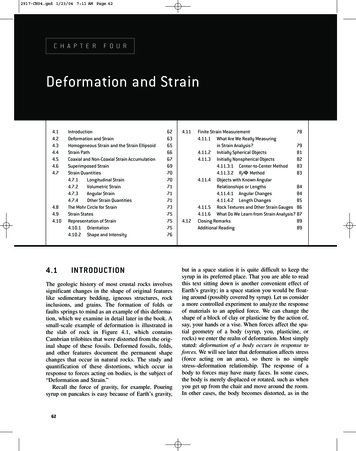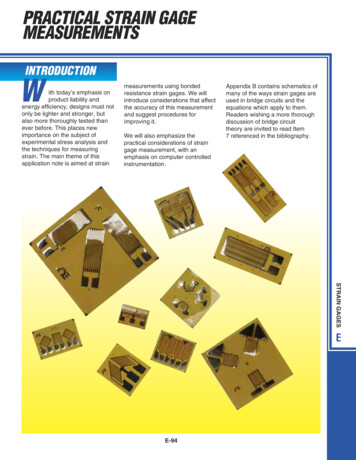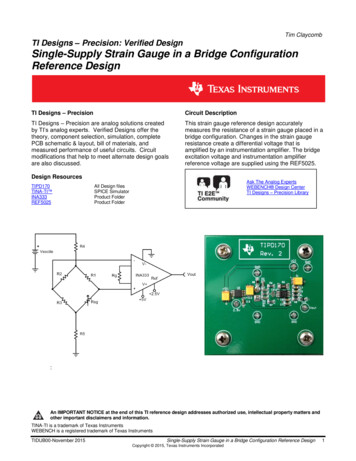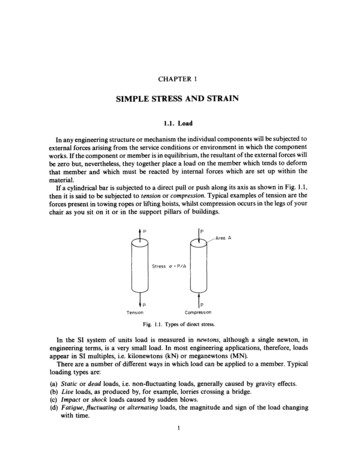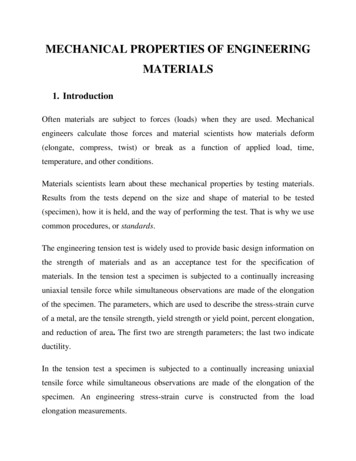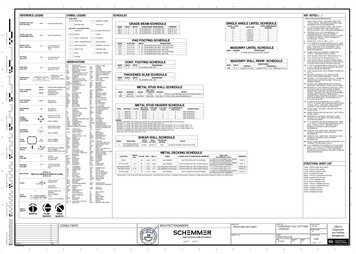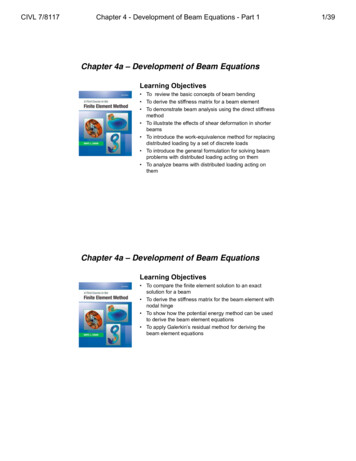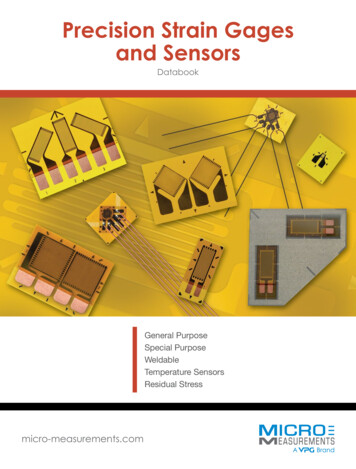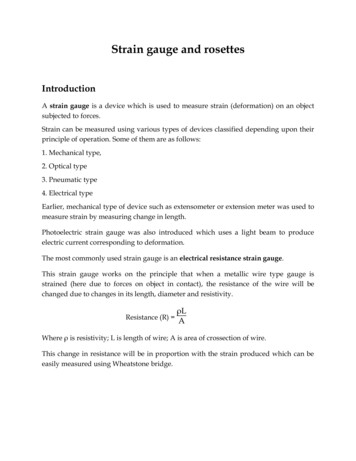
Transcription
Strain gauge and rosettesIntroductionA strain gauge is a device which is used to measure strain (deformation) on an objectsubjected to forces.Strain can be measured using various types of devices classified depending upon theirprinciple of operation. Some of them are as follows:1. Mechanical type,2. Optical type3. Pneumatic type4. Electrical typeEarlier, mechanical type of device such as extensometer or extension meter was used tomeasure strain by measuring change in length.Photoelectric strain gauge was also introduced which uses a light beam to produceelectric current corresponding to deformation.The most commonly used strain gauge is an electrical resistance strain gauge.This strain gauge works on the principle that when a metallic wire type gauge isstrained (here due to forces on object in contact), the resistance of the wire will bechanged due to changes in its length, diameter and resistivity.Resistance (R) ρLAWhere ρ is resistivity; L is length of wire; A is area of crossection of wire.This change in resistance will be in proportion with the strain produced which can beeasily measured using Wheatstone bridge.
Drawbacks of Strain gauge1. A strain gauge is capable only of measuring strain in the direction in which gauge isoriented.2. There is no direct way to measure the shear strain or to directly measure the principalstrains as directions of principal planes are not generally known.Strain rosettesSince for strain analysis in biaxial state of stress we should know strain in threedirections and due to drawbacks in a strain gauge, Strain rosettes came in to picture.Strain rosette can be defined as the arrangement of strain gauges in three arbitrarydirections.These strain gauges are used to measure the normal strain in those three directions.Depending on the arrangement of strain gauges, strain rosettes are classified in to:1. Rectangular strain gauge rosette2. Delta strain gauge rosette3. Star strain gauge rosetteRectangular strain gauge rosetteA rectangular strain rosette consists of three strain gauges arranged as follows:-YCcX45 545 A
We know normal strain in any direction (θ) is given byεn 12 (εx εy) 12 (εx – εy) cos 2θ γxy2Sin 2θεεy normal strain at a point in y- directionwhere x normal strain at a point in x-directionγxy shear strain at a point on x face in y directionSo, normal strain at θ 0 εA (εn)θ 0 12 (εx εy) 12 (εx – εy) cos 0 γxy2Sin 0 εA (εn)θ 0 12 (εx εy) 12 (εx – εy)εA (εn)θ 0 εxEqn (1)Normal strain at θ 45 (with respect to strain guage A, anticlockwise)εB (εn)θ 45 12 (εx εy) 12 (εx – εy) cos 90 εB (εn)θ 45 12 (εx εy) εx εy γxy 2 εBγxy2Sin 90 γxy2Eqn (2)Similarly, normal strain at θ 90 (with respect to strain guage A, anticlockwise)εc (εn)θ 90 12 (εx εy) 12 (εx – εy) cos 180 γxy2Sin 180
εc (εn)θ 90 12 (εx εy) - 12 (εx – εy)εc (εn)θ 90 εyEqn (3)From Eqn 1 , 2 and 3γxy 2 εB – εA – εcNote :- With the help of rectangular strain rosette we get strains in three arbitrarydirections which in turn give usεx , εy and γxy and hence principal strains at a pointon the surface of the object can be determined.Delta strain gauge rosetteA delta strain gauge also consist of three strain gauges arranged as shown below60 120 ADelta strain gauge rosetteεA (εn)θ 0 εB (εn)θ 60 εc (εn)θ 120
We know normal strain in any direction (θ) is given byεn 12 (εx εy) 12 (εx – εy) cos 2θ γxy2Sin 2θSo, normal strain at θ 0 εA (εn)θ 0 12 (εx εy) 12 (εx – εy) cos 0 γxy2Sin 0 εA (εn)θ 0 12 (εx εy) 12 (εx – εy)εA (εn)θ 0 εxEqn (4)Normal strain at θ 60 (with respect to strain gauge A, anticlockwise)εB (εn)θ 60 12 (εx εy) 12 (εx – εy) cos 120 γxy2Sin 120 Eqn (5)Similarly, normal strain at θ 120 (with respect to strain gauge A , anticlockwise)εc (εn)θ 120 12 (εx εy) 12 (εx – εy) cos 240 γxy2Sin 240 Eqn (6)Similarly,εx , εy and γxy can be determinedfrom equations 4, 5 and 6 and henceprincipal strains at a point on the surface of the object.Star strain gauge rosetteThis rosette consist of three strain gauges in three directions as shown below
120 240 AStar strain gauge rosetteεA (εn)θ 0 εB (εn)θ 120 εc (εn)θ 240 We know normal strain in any direction (θ) is given byεn 12 (εx εy) 12 (εx – εy) cos 2θ γxy2Sin 2θSo, normal strain at θ 0 εA (εn)θ 0 12 (εx εy) 12 (εx – εy) cos 0 γxy2Sin 0 εA (εn)θ 0 12 (εx εy) 12 (εx – εy)εA (εn)θ 0 εxEqn (7)Normal strain at θ 120 (with respect to strain gauge A, anticlockwise)
εB (εn)θ 120 12 (εx εy) 12 (εx – εy) cos 240 γxy2Sin 240 Eqn (8)Similarly, normal strain at θ 240 (with respect to strain gauge A, anticlockwise)εc (εn)θ 240 12 (εx εy) 12 (εx – εy) cos 480 γxy2Sin 480 Eqn (9)Similarly, by solving equations 7, 8 and 9 we can determineεx , εy and γxy and henceprincipal strains at a point on the surface of the object.Sample Question for Concept brush-upS-1. Determine maximum shear stress at a point by using the following strain gaugereadings of rectangular strain rosetteε0 400 * 10-6ε45 375 * 10-6ε90 200 * 10-6Young’s Modulus E 200 GPaPoisson ratio 0.25Solution : We know from Eqn 1 ,2 and 3εA (εn)θ 0 εx 400 * 10-6εc (εn)θ 90 εy 200 * 10-6εB (εn)θ 45 375 * 10-6andεx εy γxy 2 εB
γxy Principal strain ,150 * 10-6ε1,2 12 [( εx εy ) (ε1 425 * 10-6ε2 175 * 10-6Principal stress,1 E1-µ2 ( ε1 µ ε2)1 100 Mpa2 E1-µ2 ( ε2 µ ε1)2 Absolute τmax 1260 MpaOr1-22As principal stresses like in nature thereforeAns.Absolute τmax 12 50 MpaReferences1. Mechanics of Materials by B.C. Punmia2. Strength of Materials by R.K. Bansal)()]
Strain gauge and rosettes Introduction A strain gauge is a device which is used to measure strain (deformation) on an object subjected to forces. Strain can be measured using various types of devices classified depending upon their principle of operation. Some of them are as follows:
